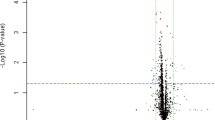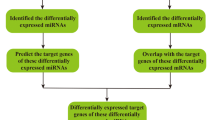Abstract
MicroRNAs are key molecules involved in the regulation of endothelial function. They are important risk factors and biomarkers for the development of hypertension related to endothelial dysfunction. However, the gene expression patterns associated with hypertension development related to endothelial dysfunction have not been fully elucidated. We conducted a case-control study of 65 patients with essential hypertension (EH) and 61 controls without EH. Plasma levels of miR-122 and its target protein high-affinity cationic amino acid transporter 1 (CAT-1) were measured by qRT-PCR and ELISA, respectively. miR-122 expression in plasma of patients with EH was significantly higher than that of the control group (p = 0.001), while CAT-1 expression in patients with EH was significantly lower than that in the control group (p = 0.018). miR-122 expression in plasma of young patients with EH was significantly higher than that in young people without EH (p = 0.0004), and CAT-1 expression in plasma of young patients with EH was also significantly lower than that of the control group (p = 0.002). CAT-1 expression in the plasma of young participants was significantly higher than that of individuals aged ≥40 years (p = 0.003), whereas miR-122 expression was significantly lower (p = 0.001). We showed that among patients with EH, the high expression of miR-122 contributed to endothelial dysfunction by suppressing the expression of the CAT-1 protein, which led to a decrease in CAT-1 expression in plasma. Therefore, high expression of miR-122 appears to be a risk factor for endothelial dysfunction in EH, especially in younger patients.
This is a preview of subscription content, access via your institution
Access options
Subscribe to this journal
Receive 12 print issues and online access
$259.00 per year
only $21.58 per issue
Buy this article
- Purchase on Springer Link
- Instant access to full article PDF
Prices may be subject to local taxes which are calculated during checkout


Similar content being viewed by others
References
Moon JY, Park KJ, Hwangbo Y, Lee MR, Yoo BI, Won JH, et al. A trend analysis of the prevalence, awareness, treatment, and control of hypertension by age group. J Prev Med Public Health. 2013;46:353–9.
Zhang Y, Moran AE. Trends in the prevalence, awareness, treatment, and control of hypertension among young adults in the United States, 1999 to 2014. Hypertension. 2017;70:736–42.
Romaine SPR, Charchar FJ, Samani NJ, Tomaszewski M. Circulating microRNAs and hypertension-from new insights into blood pressure regulation to biomarkers of cardiovascular risk. Curr Opin Pharm. 2016;27:1–7.
Chang J, Nicolas E, Marks D, Sander C, Lerro A, Buendia MA, et al. miR-122, a mammalian liver-specific miRNA, is processed from hcr mRNA and may downregulate the high affinity cationic amino acid transporter CAT-1. RNA Biol. 2005;1:106–13.
Valdmanis PN, Kim HK, Chu K, Zhang F, Xu J, Munding EM, et al. miR-122 removal in the liver activates imprinted microRNAs and enables more effective microRNA mediated gene repression. Nat Commun. 2018;9:5321.
Yang Z, Venardos K, Jones E, Morris BJ, Dusting JC, Kaye DM. Identification of a novel polymorphism in the 3′UTR of the contribution to hypertension and endothelial dysfunction. Circulation. 2007;115:1269–74.
Yang Z, Kaye DM. Mechanistic insights into the link between a polymorphism of the 3´UTR of the SLC7A1 gene and hypertension. Hum Mutat. 2009;30:328–33.
Schlaich MP, Parnell MM, Ahlers BA, Finch S, Marshall T, Zhang WZ, et al. Impaired L-arginine transport and endothelial function in hypertensive and genetically predisposed normotensive subjects. Circulation. 2004;110:3680–86.
Chin-Dusting JP, Willems L, Kaye DM. L-Arginine transporters in cardiovascular disease: a novel therapeutic target. Pharm Ther. 2007;116:428–36.
Klimczak D, Jazdzewski K, Kuch M. Regulatory mechanisms in arterial hypertension: role of microRNA in pathophysiology and therapy. Blood Press. 2017;1:2–8.
Li X, Wei Y, Wang Z. microRNA-21 and hypertension. Hypertens Res. 2018;41:649–61.
Coulouarn C, Factor VM, Andersen JB, Durkin ME, Thorgeirsson SS. Loss of miR-122 expression in liver cancer correlates with suppression of the hepatic phenotype and gain of metastatic properties. Oncogene. 2009;40:3526–36.
Cengiz M, Karatas OF, Koparir E, Yavuzer S, Ali C, Yavuzer H, et al. Differential expression of hypertension-associated microRNAs in the plasma of patients with white coat hypertension. Medicine. 2015;13:e693.
Zhou X, Wang J, Fa Y, Ye H. Signature microRNA expression profile is associated with spontaneous hypertension in African green monkey. Clin Exp Hypertens. 2019;3:287–91.
Naveed A, ur-Rahman S, Abdullah S, Naveed MA. A concise review of microRNA exploring the insights of microRNA regulations in bacterial, viral and metabolic diseases. Mol Biotechnol. 2017;59:518–29.
Konstantinidis G, Head GA, Evans RG, Nguyen-Huu TP, Venardos K, Croft KD, et al. Endothelial cationic amino acid transporter-1 overexpression can prevent oxidative stress and increases in arterial pressure in response to superoxide dismutase inhibition in mice. Acta Physiol. 2014;4:845–53.
Rajapakse NW, Mattson DL. Role of L-arginine in nitric oxide production in health and hypertension. Clin Exp Pharm Physiol. 2008;3:249–55.
Rajapaksea NW, Mattson DL. Role of cellular L-arginine uptake and nitric oxide production on renal blood flow and arterial pressure regulation. Curr Opin Nephrol Hypertens. 2013;1:45–50.
Acknowledgements
We thank Dr Jianxing Yu and Prof. Jingmei Jiang for their help with statistical assessments.
Funding
This work was supported by grants from the CAMS Initiative for Innovative Medicine (2016-I2M-3–006).
Author information
Authors and Affiliations
Corresponding author
Ethics declarations
Conflict of interest
The authors declare that they have no conflict of interest.
Ethical approval
The study protocol was approved by the Ethics Committee at the Institute of Microcirculation at the Chinese Academy of Medical Sciences (CAMS; Beijing, China) and Peking Union Medical College (PUMC; Beijing, China). The study adhered to the tenets of the Declaration of Helsinki as well as applicable Chinese laws.
Additional information
Publisher’s note Springer Nature remains neutral with regard to jurisdictional claims in published maps and institutional affiliations.
Supplementary information
Rights and permissions
About this article
Cite this article
Zhang, HG., Zhang, QJ., Li, BW. et al. The circulating level of miR-122 is a potential risk factor for endothelial dysfunction in young patients with essential hypertension. Hypertens Res 43, 511–517 (2020). https://doi.org/10.1038/s41440-020-0405-5
Received:
Revised:
Accepted:
Published:
Issue Date:
DOI: https://doi.org/10.1038/s41440-020-0405-5
Keywords
This article is cited by
-
miRNA-ome plasma analysis unveils changes in blood–brain barrier integrity associated with acute liver failure in rats
Fluids and Barriers of the CNS (2023)
-
Impact of Nutritional Epigenetics in Essential Hypertension: Targeting microRNAs in the Gut-Liver Axis
Current Hypertension Reports (2021)
-
Plasma microRNA levels in childhood IgA vasculitis
Clinical Rheumatology (2021)
-
Roles of MicroRNA-122 in Cardiovascular Fibrosis and Related Diseases
Cardiovascular Toxicology (2020)



